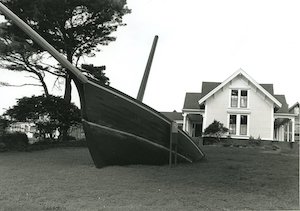
July 25, 1850 – The sailing brig Frolic ran aground on the Mendocino Coast just north of where the Point Cabrillo Lighthouse now stands. The Boston-owned Baltimore clipper was returning from China when the crew sailed too close to the shore and struck a submerged reef. The ship was bound for San Francisco where the Gold Rush had created a thriving market for the cargo of silk, porcelain plates, and other goods she carried. The captain and crew abandoned the ship and returned via rowboat to San Francisco to report the wreck.
In 1851, Jerome B. Ford came up the coast hoping to find something to salvage from the Frolic’s cargo, but he was unable to locate the shipwreck. Instead, he took back news of the immense timber stands to Henry Meiggs, an entrepreneur and alderman of San Francisco, who decided to build a sawmill on the Mendocino coast. Ford selected the headlands north of Mendocino Bay for the first mill, and the town of Mendocino (originally named Meiggsville) was founded there in July of 1852.
“Thomas H. Petersen Master Shipbuilder” by Louis A. Hough. Thomas Petersen built about three dozen wooden vessels: sailing schooners, a barkentine, steam schooners, steam tugs and lighters. Based on Petersen’s memoirs. $15.